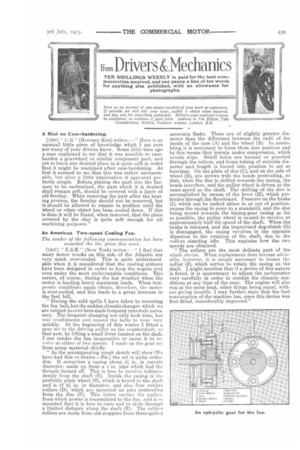TEN SHILLINGS WEEKLY is paid for the best communication received,
Page 33

If you've noticed an error in this article please click here to report it so we can fix it.
and one penny a line of ten words for anything else published, with an allowance for photographs.
Send us an account of any speeial incident of your work or exPerience. If suitable, we will edit your notes, supply a sketch when required, and pay you for everything published. Mention your employer's name, in confidence, as evidence of good faith. A dare ss to The Editor, THE COMMERCIAL MOTOR, Rosebery Avenue, London, E.C.
A Hint on Case-hardening.
[1286] " 0.B." (Ramsey Rise) writes : —" Here is an unusual little piece of knowledge which I am sure not many of your drivers know. Some little time ago a man explained to me that it was possible to caseharden a gearwheel or similar component part, and yet to leave any desired place in. it quite soft in order that it might be machined after case-hardening. At first it seemed to me that this was rather unreasonable, but after a little explanation it appeared perfectly simple. Before placing the part into the furnace to be carbonized, the part which it is desired shall remain soft, should be covered with a layer of old &Belay. When removing the part after the heating process, the fireclay should not be removed, but it should be allowed to remain in. position until the wheel or other object has been cooled down. If this is done it will be found, when removed, that the place covered by the clay is quite soft enough for all machining purposes."
An American Two-speed Cooling Fan.
The sender of the following communication has been awarded the 10s. prize this week.
[1287] " E.S.H." (New York) writes :—" I find that many motor trucks on this side of the Atlantic are very much over-cooled. This is quite understandable when it is considered that the cooling :systems have been designed in order to keep the engine cool even under the most unfavourable conditions. This occurs, of course, during the hot weather when the motor is hauling heavy maximum loads. When temperate conditions again, obtain, therefore, the motor is over-coaled, and this leads to a great increase in the fuel bill.
"During the cold spells I have taken to removing the fan belt, but the sudden climatic changes which we are subject to over here made frequent renewals necessary. The frequent changing not only took time, but was troublesome and caused the belts to wear very quickly. At the beginning of this winter I fitted a gear set to the driving pulley on the countershaft, so that now, by lifting a small lever located on the dash, I can render the fan inoperative or cause it to revolve at either of two speeds. I made up the gear set from scrap material chiefly. "AR the accompanying rough sketch will show [We have had this re-drawn.—En.] the set is quite orthodox. It comprises a casing about 41. in. in outside diameter, made up from a 4 in. pipe which had the threads turned off. This is free to revolve independently from the shaft (E). Inside the casing is the perfectly plain wheel (B), which is keyed to the shaft and in of 24 in. in diameter, and also four rubber rollers (D), which are mounted on pins protruding from the disc (F). This latter carries the pulley. from which power is transmitted to the fan, and is so mounted that it is free to turn and to slide through a limited distance along the shaft (E). The rubber rollers are made from old stoppers from three-gallon ammonia flasks. These are of slightly greater diameter than the difference between the radii of the inside of the case (A) and the wheel (B). In assembling it is necessary to force them into position and by this means they remain under compression, which avoids slips. Small holes are burned or punched through the rollers, and brass tubing of suitable diameter and length is forced into position to act as bearings. On the plate of disc (0), and on the side of wheel (B), are screws with the heads protruding, so that, when the disc is shifted towards the casing, the heads interfere, and the pulley wheel is driven at the same speed as the shaft. The shifting of the disc is accomplished by means of the lever (H), which protrudes through the floorboard. Pressure on the brake (I), which can be locked either in or out of position, causes the casing to come to a standstill, and the disc being moved towards the timing-gear casing an far as possible, the pulley wheel is caused to revolve at approximately half the speed of the shaft. When the brake is released, and the improvised dog-clutch (G) is disengaged, the casing revolves in the opposite direction to the rotation of the shaft, due to the rollers standing idle. This explains bow the two speeds are obtained. "The rollers are the most delicate part of the whole device. When replacement does become advisable, however, it is simply necessary to loosen the collar (J), which serves to retain the casing on the shaft. I might mention that if a device of this nature is fitted, it is unnecessary to adjust the carburetter very carefully in order to combat the climatic conditions at any time of the year. The engine will also run at the same heat, other things being equal, without giving trouble. I may further state that the fuel consumption of the machine has, since this device was first fitted, considerably improved."


































